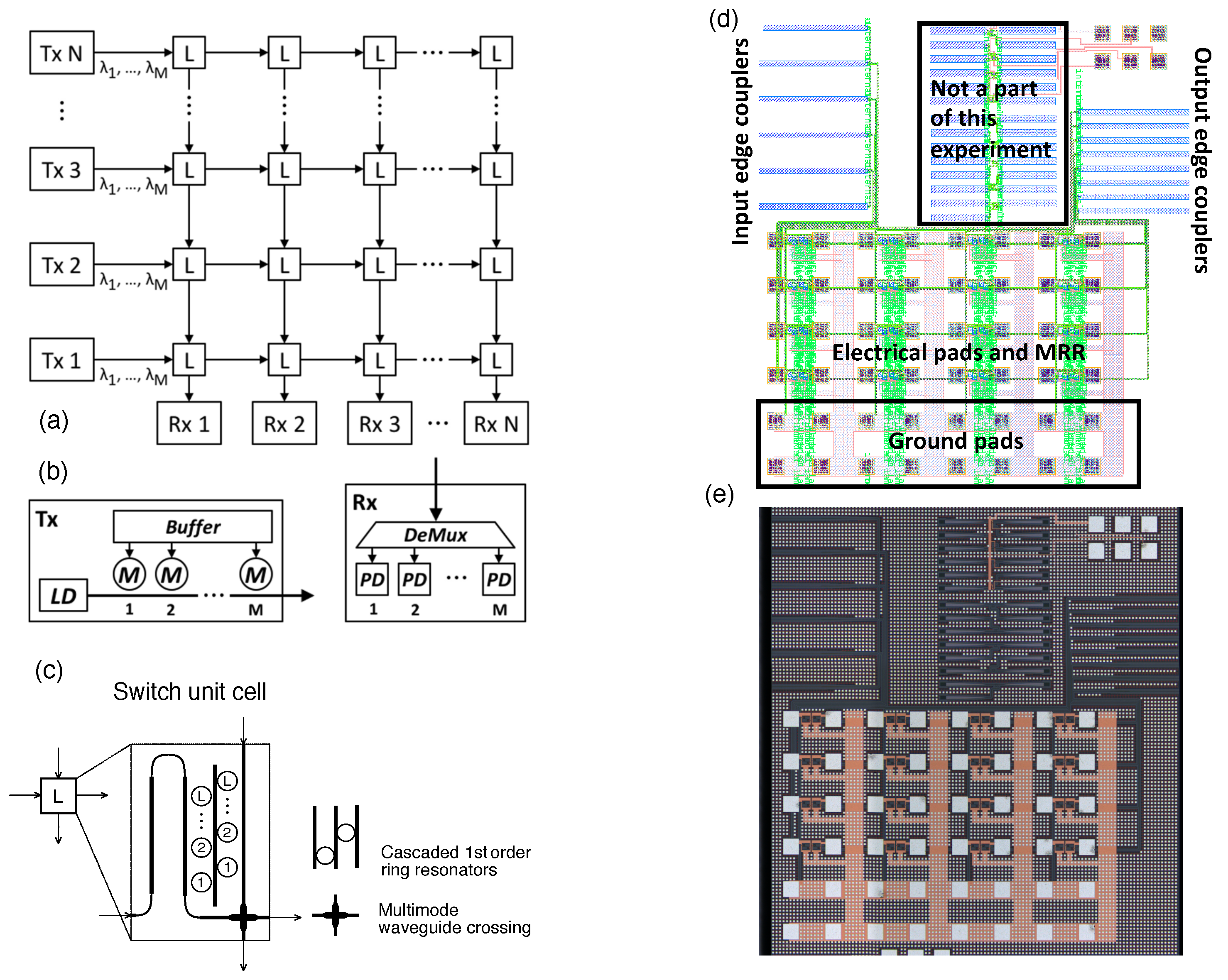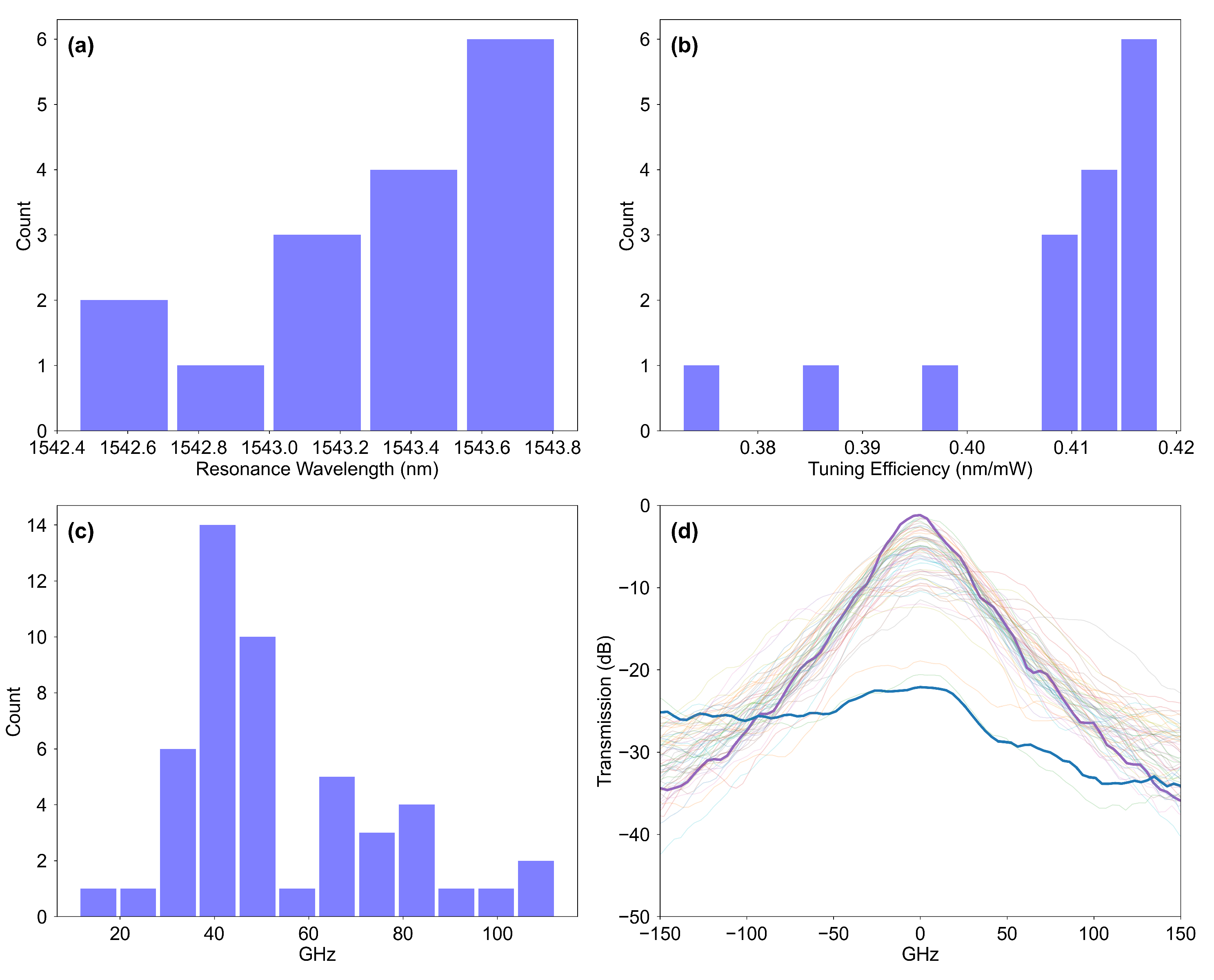Compact Wavelength Selective Crossbar Switch with Cascaded First Order Micro-Ring Resonators
Abstract
:1. Introduction
2. Architecture
3. Results
4. Discussion
5. Conclusions
Author Contributions
Funding
Conflicts of Interest
References
- Saleh, A.A.M.; Khope, A.S.P.; Bowers, J.E.; Alferness, R.C. Elastic WDM switching for scalable data center and HPC interconnect networks. In Proceedings of the OptoElectronics and Communications Conference (OECC), Niigata, Japan, 3–7 July 2016; pp. 1–3. [Google Scholar]
- Khope, A.S.P.; Samanta, A.; Xiao, X.; Yoo, B.; Bowers, J.E. Review Of Integrated Photonic Elastic WDM Switches For Data Centers. arXiv 2021, arXiv:2105.14934. [Google Scholar]
- Xiao, X.; Proietti, R.; Werner, S.; Fotouhi, P.; Yoo, S.B. Flex-LIONS: A scalable silicon photonic bandwidth-reconfigurable optical switch fabric. In Proceedings of the 2019 24th OptoElectronics and Communications Conference (OECC) and 2019 International Conference on Photonics in Switching and Computing (PSC), Fukuoka, Japan, 7–11 July 2019; pp. 1–3. [Google Scholar]
- Khope, A.S.; Saeidi, M.; Yu, R.; Wu, X.; Netherton, A.M.; Liu, Y.; Zhang, Z.; Xia, Y.; Fleeman, G.; Spott, A.; et al. Multi-wavelength selective crossbar switch. Opt. Express 2019, 27, 5203–5216. [Google Scholar] [CrossRef] [PubMed]
- Seok, T.J.; Luo, J.; Huang, Z.; Kwon, K.; Henriksson, J.; Jacobs, J.; Ochikubo, L.; Muller, R.S.; Wu, M.C. Silicon photonic wavelength cross-connect with integrated MEMS switching. APL Photonics 2019, 4, 100803. [Google Scholar] [CrossRef]
- Xiao, X.; Proietti, R.; Liu, G.; Lu, H.; Zhang, Y.; Yoo, S.B. Multi-FSR Silicon Photonic Flex-LIONS Module for Bandwidth-Reconfigurable All-to-All Optical Interconnects. J. Light. Technol. 2020, 38, 3200–3208. [Google Scholar] [CrossRef]
- Khope, A.S.P.; Liu, S.; Zhang, Z.; Netherton, A.M.; Hwang, R.L.; Wissing, A.; Perez, J.; Tang, F.; Schow, C.; Helkey, R.; et al. 2 λ switch. Opt. Lett. 2020, 45, 5340–5343. [Google Scholar] [CrossRef] [PubMed]
- Khope, A.S.; Helkey, R.; Liu, S.; Khope, S.; Alferness, R.C.; Saleh, A.A.; Bowers, J.E. Scalable multicast hybrid broadband-crossbar wavelength selective switch: Proposal and analysis. Opt. Lett. 2021, 46, 448–451. [Google Scholar] [CrossRef] [PubMed]
- Khope, A.S.; Hirokawa, T.; Netherton, A.M.; Saeidi, M.; Xia, Y.; Volet, N.; Schow, C.; Helkey, R.; Theogarajan, L.; Saleh, A.A.; et al. On-chip wavelength locking for photonic switches. Opt. Lett. 2017, 42, 4934–4937. [Google Scholar] [CrossRef] [Green Version]
- Huang, Y.; Cheng, Q.; Rizzo, A.; Bergman, K. High-Performance Microring-Assisted Space-and-Wavelength Selective Switch. In Proceedings of the Optical Fiber Communication Conference (OFC), San Diego, CA, USA, 8–12 March 2020; pp. 1–3. [Google Scholar]
- Khope, A.S.P.; Helkey, R.; Liu, S.; Saleh, A.A.M.; Alferness, R.C.; Bowers, J.E. A Scalable Multicast Hybrid Broadband Crossbar Wavelength Selective Switch For Datacenters. In Proceedings of the 2021 IEEE 11th Annual Computing and Communication Workshop and Conference (CCWC), NV, USA, 27–30 January 2021; pp. 1585–1587. [Google Scholar] [CrossRef]
- Khope, A.S.; Liu, S.; Netherton, A.; Zhang, Z.; Khope, S.; Helkey, R.; Saleh, A.A.; Alferness, R.C.; Bowers, J.E. Experiments on Multiwavelength Selective Crossbar Switches. In Proceedings of the 2020 International Conference on Information Science and Communications Technologies (ICISCT), Tashkent, Uzbekistan, 4–6 November 2020; pp. 1–5. [Google Scholar] [CrossRef]
- Khope, A.S.P.; Saleh, A.A.M.; Bowers, J.E.; Alferness, R.C. Elastic WDM crossbar switch for data centers. In Proceedings of the IEEE Optical Interconnects (OI) Conference, San Diego, CA, USA, 9–11 May 2016; pp. 48–49. [Google Scholar]
- Khope, A.S.P. Lumos: A Python Instrument Control Library for Photonics. Preprints 2021, 2021060015. [Google Scholar] [CrossRef]
- Khope, A.S.P. Ultralow Loss Adiabatic Microring Resonator With Thermal Tuning. Preprints 2021, 2021060186. [Google Scholar] [CrossRef]
- Bahadori, M.; Gazman, A.; Janosik, N.; Rumley, S.; Zhu, Z.; Polster, R.; Cheng, Q.; Bergman, K. Thermal Rectification of Integrated Microheaters for Microring Resonators in Silicon Photonics Platform. J. Light. Technol. 2018, 36, 773–788. [Google Scholar] [CrossRef]
- Ikeda, K.; Suzuki, K.; Konoike, R.; Kawashima, H. Silicon Photonics Wavelength Selective Switch with Unlimited Free Spectral Range. J. Light. Technol. 2020, 38, 3268–3272. [Google Scholar] [CrossRef]
- Ma, Y.; Zhang, Y.; Yang, S.; Novack, A.; Ding, R.; Lim, A.E.J.; Lo, G.Q.; Baehr-Jones, T.; Hochberg, M. Ultralow loss single layer submicron silicon waveguide crossing for SOI optical interconnect. Opt. Express 2013, 21, 29374–29382. [Google Scholar] [CrossRef] [PubMed]





| References | Port Count | Path Loss | Crosstalk |
|---|---|---|---|
| NIAIST [17] 2020 | 2 × 2 | 0.5 dB | 15/20 dB * |
| UCD [6] 2020 | 8 × 8 | <8.4 dB | 5.3 dB ** |
| UCB [5] 2018 | 8 × 8 | 8.8–16.4 dB | 30 dB |
| UCSB [9] 2019 | 8 × 8 | 5–45 dB | 35/40 dB *** |
| UCSB [4] 2019 | 8 × 4 | 6–14 dB | 20/32 dB *** |
| UCSB [7] 2020 | 4 × 4 | 0.8–5 dB | 22/32 dB *** |
| UCSB This work | 4 × 4 | 0.9–20 dB | 40 dB **** |
Publisher’s Note: MDPI stays neutral with regard to jurisdictional claims in published maps and institutional affiliations. |
© 2022 by the authors. Licensee MDPI, Basel, Switzerland. This article is an open access article distributed under the terms and conditions of the Creative Commons Attribution (CC BY) license (https://creativecommons.org/licenses/by/4.0/).
Share and Cite
P. Khope, A.S.; Zhang, R.; Helkey, R.; Alferness, R.C.; Saleh, A.A.M.; Bowers, J.E. Compact Wavelength Selective Crossbar Switch with Cascaded First Order Micro-Ring Resonators. Photonics 2022, 9, 60. https://doi.org/10.3390/photonics9020060
P. Khope AS, Zhang R, Helkey R, Alferness RC, Saleh AAM, Bowers JE. Compact Wavelength Selective Crossbar Switch with Cascaded First Order Micro-Ring Resonators. Photonics. 2022; 9(2):60. https://doi.org/10.3390/photonics9020060
Chicago/Turabian StyleP. Khope, Akhilesh S., Robert Zhang, Roger Helkey, Rod C. Alferness, Adel A. M. Saleh, and John E. Bowers. 2022. "Compact Wavelength Selective Crossbar Switch with Cascaded First Order Micro-Ring Resonators" Photonics 9, no. 2: 60. https://doi.org/10.3390/photonics9020060
APA StyleP. Khope, A. S., Zhang, R., Helkey, R., Alferness, R. C., Saleh, A. A. M., & Bowers, J. E. (2022). Compact Wavelength Selective Crossbar Switch with Cascaded First Order Micro-Ring Resonators. Photonics, 9(2), 60. https://doi.org/10.3390/photonics9020060






